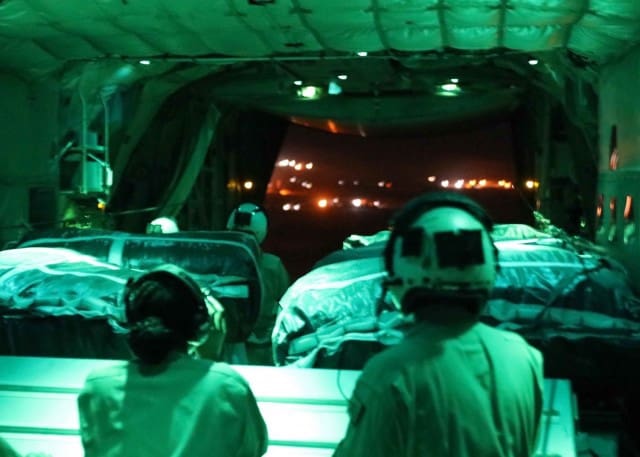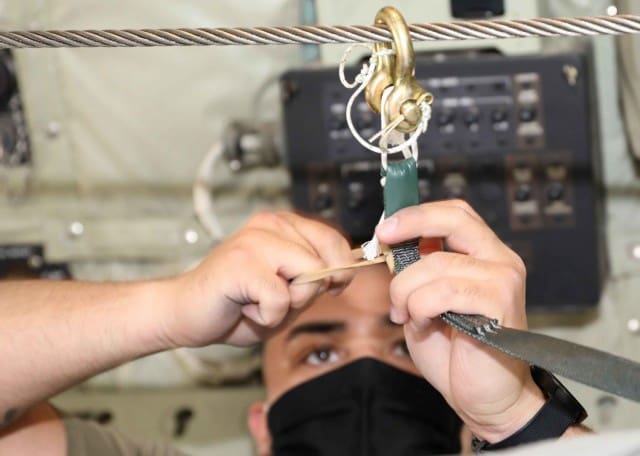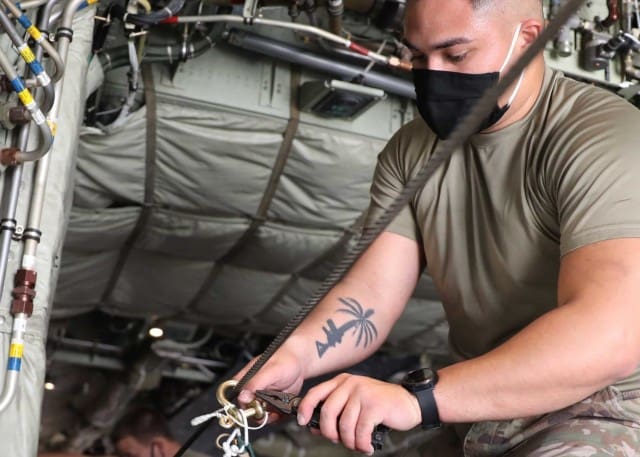CAMP ARIFJAN, Kuwait — Soldiers with the 1st Theater Sustainment Command’s operational command post, or 1st TSC-OCP, headquartered here, successfully executed joint airdrop missions with a Marine C-130J Hercules aircrew and Army riggers in the U.S. Central Command’s area of operations.

Pallets loaded with key medical supplies, food and other materiel were delivered in three drops to different locations, said Army Warrant Officer Michael Romeo, who works in the air section of the 1st TSC-OCP Support Operations, or the SPO shop.
The aircrew belongs to the Marine Aerial Refueler Transport Squadron-352, Detachment A, and are known as the “Raiders” Romeo said.
“These missions are definitely a high priority,” said Romeo, who is a warrant officer in the 165th Quartermaster Company, Georgia National Guard, but now serving with the Army Reserve’s 310th Sustainment Command (Expeditionary), based in Indianapolis, Indiana. The 310th ESC acts as the staff for the 1st TSC-OCP.
Romeo, who was on the mission as an observer for the 1st TSC-OCP, said the airdrops are a regular part of 1st TSC-OCP’s support for personnel forward deployed, especially for perishable medical and food supplies.

“They will send in an airdrop request for review, and then it comes to me,” he said. “The biggest thing we do as logisticians and sustainers is making sure we are getting the right equipment and supplies to the people who need it,” he said. “Using aerial delivery is a quick and easy way to do that.”
The 101st Sustainment Brigade, based at Fort Campbell, Kentucky, and the 151st Quartermaster Detachment from Fort Bragg, North Carolina, also supported the air drop operations, he said.
Marine Gunnery Sgt. David Hoyt, the loadmaster for the flight, said he was impressed by the Army riggers.
“They are quick and focused and do a good job,” he said. “They understand we have time constraints and got the job done.”
Army Spc. Christian Ramos, 151st Quartermaster Detachment, said he is a team leader for airdrop system, equipment and repair.
The Guam native said once the pallets were loaded onto the aircraft, he and the other riggers use strings and rubber bands to attach the parachutes to the static lines on both the left and right sides of the plane.
“The static line is connected to the G-14 clevis, upon deployment, it will pull the parachute off,” Ramos said. “The strings I was attaching with the rubber or retainer band, are called anti-oscillation ties, so they prevent the static line from moving around in flight and getting tangled.”

The G-14 is a U-shaped piece of metal that slides on the static line, like a curtain ring on a curtain rod. When the pallet reaches the plane’s back door, the rubber band snaps from the weight of the pallet and the parachute deploys.
Ramos said this air drop mission was his first time as a joint airdrop inspector. “It means that I am inspecting the loads and ensuring that these loads are free of deficiencies, which reduces the likelihood of a malfunction, so the guys on the ground can get the supplies that they need.”
Spc. Hope Mastroberti, a parachute rigger, 151st Quartermaster Detachment, said during this deployment, she was able to attend the Joint Air Load Inspector course.
Mastroberti, a native of Crystal River, Florida, said she loves being a rigger, a job she has had for two years. “I love the opportunities I’m provided. I pack personal parachutes and I pack heavy rigging parachutes.”
By SSG Neil W. McCabe

